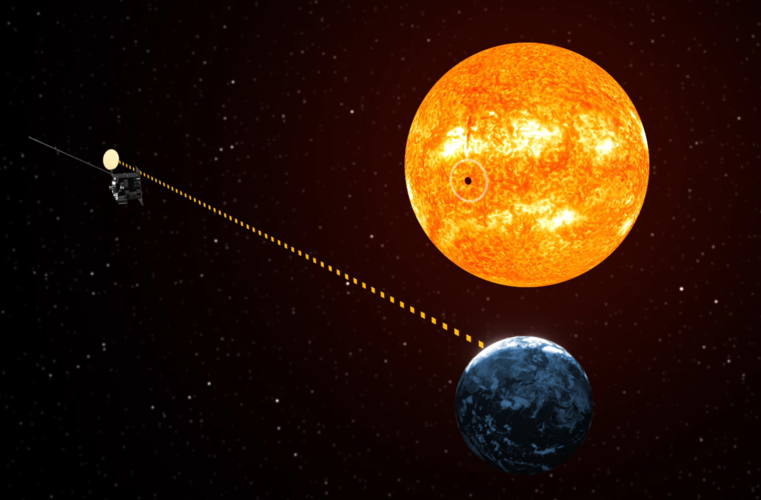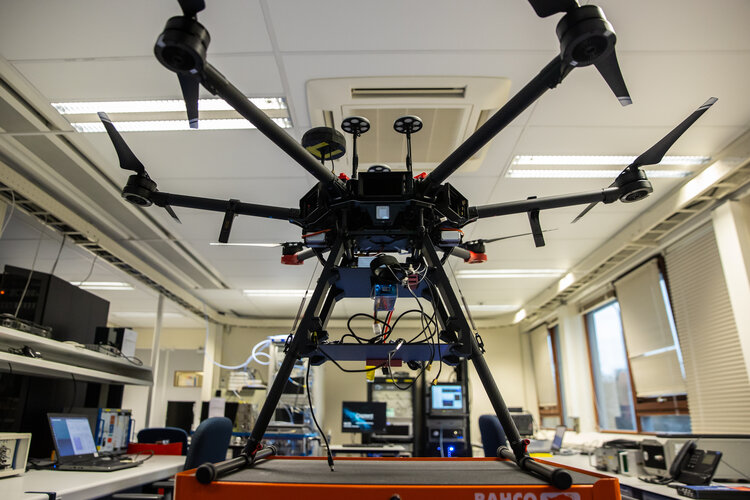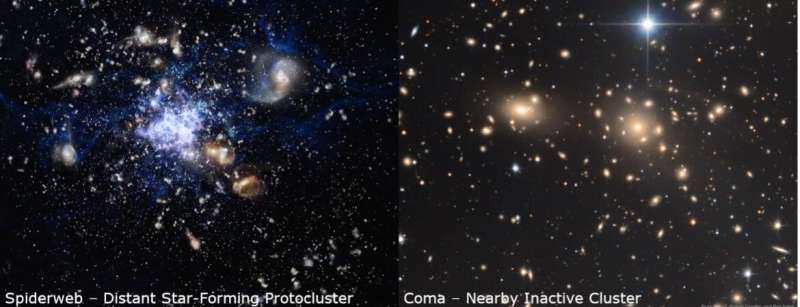
Copernical Team
Thursday, 10 February 2022 09:00
Introducing ESA Vigil: Earth’s devoted solar defender

Once known as “Lagrange,” ESA’s upcoming space weather mission needed a new name that would reflect its vital role: helping to protect Earth’s infrastructure, satellites, inhabitants and space explorers from unpredictable but violent solar events like solar flares and ‘coronal mass ejections’.
With 5422 submissions from across Europe and indeed around the world – and after weeks of deliberation, countless spreadsheets, three diverse and expert judges and a lively debate – a new name has been selected for our upcoming space weather mission: ESA Vigil.
Published in
News
Tagged under
Thursday, 10 February 2022 11:02
The drone has landed
 Image:
The drone has landed
Image:
The drone has landed
Published in
News
Tagged under
Wednesday, 09 February 2022 21:03
Surprisingly high fraction of dead galaxies found in ancient galactic 'city'

Published in
News
Tagged under
Thursday, 10 February 2022 00:28
A new programming language for high-performance computers
Boston MA (SPX) Feb 09, 2022
 High-performance computing is needed for an ever-growing number of tasks - such as image processing or various deep learning applications on neural nets - where one must plow through immense piles of data, and do so reasonably quickly, or else it could take ridiculous amounts of time. It's widely believed that, in carrying out operations of this sort, there are unavoidable trade-offs between spe
High-performance computing is needed for an ever-growing number of tasks - such as image processing or various deep learning applications on neural nets - where one must plow through immense piles of data, and do so reasonably quickly, or else it could take ridiculous amounts of time. It's widely believed that, in carrying out operations of this sort, there are unavoidable trade-offs between spe
 High-performance computing is needed for an ever-growing number of tasks - such as image processing or various deep learning applications on neural nets - where one must plow through immense piles of data, and do so reasonably quickly, or else it could take ridiculous amounts of time. It's widely believed that, in carrying out operations of this sort, there are unavoidable trade-offs between spe
High-performance computing is needed for an ever-growing number of tasks - such as image processing or various deep learning applications on neural nets - where one must plow through immense piles of data, and do so reasonably quickly, or else it could take ridiculous amounts of time. It's widely believed that, in carrying out operations of this sort, there are unavoidable trade-offs between spe
Published in
News
Tagged under
Thursday, 10 February 2022 00:28
The abyssal world: the last terra incognita of the Earth surface
Bremen, Germany (SPX) Feb 07, 2022
 The deep-ocean floor is the least explored ecosystem on the planet, despite covering more than 60% of the Earth surface. Largely unknown life in abyssal sediments, from benthic animals to microbes, helps to recycle and/or sequester the sinking (in)organic matter originating from pelagic communities that are numerically dominated by microscopic plankton.
Benthic ecosystems thus underpin two
The deep-ocean floor is the least explored ecosystem on the planet, despite covering more than 60% of the Earth surface. Largely unknown life in abyssal sediments, from benthic animals to microbes, helps to recycle and/or sequester the sinking (in)organic matter originating from pelagic communities that are numerically dominated by microscopic plankton.
Benthic ecosystems thus underpin two
 The deep-ocean floor is the least explored ecosystem on the planet, despite covering more than 60% of the Earth surface. Largely unknown life in abyssal sediments, from benthic animals to microbes, helps to recycle and/or sequester the sinking (in)organic matter originating from pelagic communities that are numerically dominated by microscopic plankton.
Benthic ecosystems thus underpin two
The deep-ocean floor is the least explored ecosystem on the planet, despite covering more than 60% of the Earth surface. Largely unknown life in abyssal sediments, from benthic animals to microbes, helps to recycle and/or sequester the sinking (in)organic matter originating from pelagic communities that are numerically dominated by microscopic plankton.
Benthic ecosystems thus underpin two
Published in
News
Tagged under
Thursday, 10 February 2022 00:28
Operational Optical Data Services for Meteosat Satellites
Madrid, Spain (SPX) Feb 09, 2022
 Following an open invitation to tender, the technology multinational GMV, European industrial leader in Space Situational Awareness (SSA) and Space Surveillance and Tracking (SST), has been awarded a new contract by the European Organisation for the Exploitation of Meteorological Satellites (EUMETSAT), located in Darmstadt (Germany) for the provision of Operational Optical Data Services to suppo
Following an open invitation to tender, the technology multinational GMV, European industrial leader in Space Situational Awareness (SSA) and Space Surveillance and Tracking (SST), has been awarded a new contract by the European Organisation for the Exploitation of Meteorological Satellites (EUMETSAT), located in Darmstadt (Germany) for the provision of Operational Optical Data Services to suppo
 Following an open invitation to tender, the technology multinational GMV, European industrial leader in Space Situational Awareness (SSA) and Space Surveillance and Tracking (SST), has been awarded a new contract by the European Organisation for the Exploitation of Meteorological Satellites (EUMETSAT), located in Darmstadt (Germany) for the provision of Operational Optical Data Services to suppo
Following an open invitation to tender, the technology multinational GMV, European industrial leader in Space Situational Awareness (SSA) and Space Surveillance and Tracking (SST), has been awarded a new contract by the European Organisation for the Exploitation of Meteorological Satellites (EUMETSAT), located in Darmstadt (Germany) for the provision of Operational Optical Data Services to suppo
Published in
News
Tagged under
Thursday, 10 February 2022 00:28
Glaciers are melting faster and with more consequences than expected
Berlin, Germany (SPX) Feb 02, 2022
 Developments at the South Pole are raising new concerns. A group of smaller glaciers, named Pope, Smith and Kohler, are melting faster than expected. So far, the neighbouring giant glaciers, Thwaites and Pine Island, have been the focus of research because they are extremely fragile and could raise global sea levels by up to 1.2 metres.
The German Aerospace Center (Deutsches Zentrum fur Lu
Developments at the South Pole are raising new concerns. A group of smaller glaciers, named Pope, Smith and Kohler, are melting faster than expected. So far, the neighbouring giant glaciers, Thwaites and Pine Island, have been the focus of research because they are extremely fragile and could raise global sea levels by up to 1.2 metres.
The German Aerospace Center (Deutsches Zentrum fur Lu
 Developments at the South Pole are raising new concerns. A group of smaller glaciers, named Pope, Smith and Kohler, are melting faster than expected. So far, the neighbouring giant glaciers, Thwaites and Pine Island, have been the focus of research because they are extremely fragile and could raise global sea levels by up to 1.2 metres.
The German Aerospace Center (Deutsches Zentrum fur Lu
Developments at the South Pole are raising new concerns. A group of smaller glaciers, named Pope, Smith and Kohler, are melting faster than expected. So far, the neighbouring giant glaciers, Thwaites and Pine Island, have been the focus of research because they are extremely fragile and could raise global sea levels by up to 1.2 metres.
The German Aerospace Center (Deutsches Zentrum fur Lu
Published in
News
Tagged under
Thursday, 10 February 2022 00:28
SBIRS GEO-5 operationally accepted after exceeding on-orbit testing expectations
Peterson SFB CO (SPX) Feb 08, 2022
 The fifth Space Based Infrared System Geosynchronous Earth Orbit (SBIRS GEO-5) satellite built by Lockheed Martin, has been operationally accepted by the U.S. Space Force less than a year after being launched into orbit.
The early missile warning satellite is a "Go-Fast" success story, completing all on-orbit testing with accelerated analysis, resulting in a 40% improvement over GEO-1 thro
The fifth Space Based Infrared System Geosynchronous Earth Orbit (SBIRS GEO-5) satellite built by Lockheed Martin, has been operationally accepted by the U.S. Space Force less than a year after being launched into orbit.
The early missile warning satellite is a "Go-Fast" success story, completing all on-orbit testing with accelerated analysis, resulting in a 40% improvement over GEO-1 thro
 The fifth Space Based Infrared System Geosynchronous Earth Orbit (SBIRS GEO-5) satellite built by Lockheed Martin, has been operationally accepted by the U.S. Space Force less than a year after being launched into orbit.
The early missile warning satellite is a "Go-Fast" success story, completing all on-orbit testing with accelerated analysis, resulting in a 40% improvement over GEO-1 thro
The fifth Space Based Infrared System Geosynchronous Earth Orbit (SBIRS GEO-5) satellite built by Lockheed Martin, has been operationally accepted by the U.S. Space Force less than a year after being launched into orbit.
The early missile warning satellite is a "Go-Fast" success story, completing all on-orbit testing with accelerated analysis, resulting in a 40% improvement over GEO-1 thro
Published in
News
Tagged under
Thursday, 10 February 2022 00:28
Raytheon Intelligence and Space Releases Latest Increment of FORGE Data Framework
Aurora CO (SPX) Feb 09, 2022
 Raytheon Intelligence and Space, a Raytheon Technologies business, released version 9.0 of the Future Operationally Resilient Ground Evolution, or FORGE, Mission Data Processing Application Framework.
Release 9.0 of the government-owned framework continues to evolve existing features such as scalability, visualization, cybersecurity hardening, and integration for the Overhead Persistent In
Raytheon Intelligence and Space, a Raytheon Technologies business, released version 9.0 of the Future Operationally Resilient Ground Evolution, or FORGE, Mission Data Processing Application Framework.
Release 9.0 of the government-owned framework continues to evolve existing features such as scalability, visualization, cybersecurity hardening, and integration for the Overhead Persistent In
 Raytheon Intelligence and Space, a Raytheon Technologies business, released version 9.0 of the Future Operationally Resilient Ground Evolution, or FORGE, Mission Data Processing Application Framework.
Release 9.0 of the government-owned framework continues to evolve existing features such as scalability, visualization, cybersecurity hardening, and integration for the Overhead Persistent In
Raytheon Intelligence and Space, a Raytheon Technologies business, released version 9.0 of the Future Operationally Resilient Ground Evolution, or FORGE, Mission Data Processing Application Framework.
Release 9.0 of the government-owned framework continues to evolve existing features such as scalability, visualization, cybersecurity hardening, and integration for the Overhead Persistent In
Published in
News
Tagged under
Thursday, 10 February 2022 00:28
Air Force awards contract for spaceborne weather data
Hanscom AFB MA (SPX) Feb 08, 2022
 A Hanscom team recently awarded a $19.3 million contract to support a constellation of high-tech weather satellites capable of observing precipitation and storm structures from space. As part of the agreement, Boston-based meteorological intelligence company Tomorrow.io will provide the Aerospace Management Systems Division, headquartered here, with three-dimensional global weather and ocean dat
A Hanscom team recently awarded a $19.3 million contract to support a constellation of high-tech weather satellites capable of observing precipitation and storm structures from space. As part of the agreement, Boston-based meteorological intelligence company Tomorrow.io will provide the Aerospace Management Systems Division, headquartered here, with three-dimensional global weather and ocean dat
 A Hanscom team recently awarded a $19.3 million contract to support a constellation of high-tech weather satellites capable of observing precipitation and storm structures from space. As part of the agreement, Boston-based meteorological intelligence company Tomorrow.io will provide the Aerospace Management Systems Division, headquartered here, with three-dimensional global weather and ocean dat
A Hanscom team recently awarded a $19.3 million contract to support a constellation of high-tech weather satellites capable of observing precipitation and storm structures from space. As part of the agreement, Boston-based meteorological intelligence company Tomorrow.io will provide the Aerospace Management Systems Division, headquartered here, with three-dimensional global weather and ocean dat
Published in
News
Tagged under
